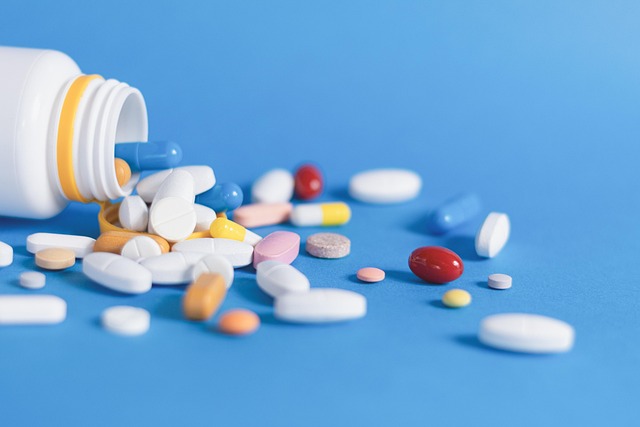GLP-1 drugs, mimicking the gut hormone GLP-1, are a versatile class of medications benefiting diabetes management by regulating blood sugar and enhancing insulin secretion. Beyond diabetes, these drugs offer cardiovascular advantages, reducing major cardiac events, improving heart function, and managing conditions like heart failure and atherosclerosis. Mechanisms include vasodilation, anti-inflammatory effects, and improved endothelial function. Clinical trials highlight their safety and potential as standalone cardiovascular medications. Future directions involve personalized medicine, advanced delivery methods, and combination therapies, aiming to revolutionize cardiovascular care by addressing multiple risk factors simultaneously.
GLP-1 agonists, a class of medications mimicking the effects of gut hormones, have emerged as promising candidates for cardiovascular health management. This article delves into the multifaceted role of GLP-1 drugs, exploring their mechanisms in blood sugar regulation and the growing evidence supporting their cardiovascular benefits. From emerging clinical trials to safety considerations and future personalized treatment approaches, we unravel the potential of these agonists in revolutionizing cardiovascular care.
Understanding GLP-1 Agonists and Their Function in the Body

GLP-1 agonists are a class of drugs that mimic the effects of glucagon-like peptide-1 (GLP-1), a hormone produced in the gut in response to food intake. This hormone plays a crucial role in regulating blood sugar levels by stimulating insulin secretion when needed and suppressing glucagon release, which helps reduce blood glucose. GLP-1 agonists enhance these actions, leading to improved glycemic control, making them an essential part of diabetes management.
Beyond their effect on blood sugar, recent research has unveiled the beneficial role of GLP-1 drugs in cardiovascular health. Studies have shown that these agonists can lower blood pressure, reduce inflammation, and improve lipid profiles, thereby contributing to a healthier heart and vessels. The multi-faceted benefits of GLP-1 make it an exciting area of study for researchers aiming to combat both diabetes and cardiovascular diseases simultaneously.
The Impact of GLP-1 Drugs on Blood Sugar Regulation

GLP-1 drugs, or glucagon-like peptide-1 agonists, have made significant strides in blood sugar regulation. These pharmaceutical agents mimic a natural hormone produced by the gut to stimulate insulin secretion when blood glucose levels rise, thereby helping to lower them. This action is particularly beneficial for individuals with type 2 diabetes, as it enhances their body’s ability to manage blood sugar effectively.
The impact extends beyond glycemic control. GLP-1 drugs also promote weight loss and reduce appetite by increasing feelings of fullness, which can lead to healthier eating habits. Additionally, they have cardiovascular benefits, including improved heart function and reduced risks of cardiovascular events. This dual role in managing both metabolic health and heart wellness makes GLP-1 drugs a valuable tool in comprehensive healthcare strategies.
Cardiovascular Benefits of GLP-1 Therapy: Emerging Evidence

The role of GLP-1 agonists in cardiovascular health is a burgeoning area of interest, with emerging evidence suggesting significant benefits beyond their well-known effects on glycemic control. Studies have shown that GLP-1 drugs can offer protective effects against various cardiovascular diseases. These drugs have been found to reduce the risk of major adverse cardiac events, such as heart attacks and strokes, in patients with type 2 diabetes and established cardiovascular disease.
Research indicates that GLP-1 agonists may improve cardiovascular outcomes by promoting vasodilation, reducing inflammation, and modulating blood pressure. Additionally, they have been linked to a decrease in left ventricular mass, indicating improved cardiac function over time. The potential for these GLP-1 drugs to act as a cardioprotective agent is an exciting development, opening up new possibilities for managing cardiovascular risk in high-priority patient populations.
Mechanisms Behind GLP-1's Protective Effects on the Heart and Vessels

GLP-1, or glucagon-like peptide-1, has been a subject of interest in cardiovascular research due to its multifaceted protective effects on the heart and blood vessels. The mechanisms behind these benefits are intricate and involve several key processes. Firstly, GLP-1 drugs stimulate the proliferation and differentiation of vascular smooth muscle cells, promoting the growth of new blood vessels and enhancing endothelial function. This leads to improved blood flow and reduced oxygen demand from the heart.
Additionally, GLP-1 has been shown to reduce inflammation and oxidative stress in cardiovascular tissues, which are major contributors to atherosclerosis and heart disease. It achieves this by inhibiting pro-inflammatory cytokine production and increasing anti-inflammatory markers. Furthermore, GLP-1 agonists improve insulin sensitivity and glycemic control, thereby reducing the metabolic risk factors associated with cardiovascular diseases.
Clinical Trials: Exploring the Efficacy of GLP-1 Drugs in Cardiovascular Health

Clinical trials have played a pivotal role in unraveling the potential benefits of GLP-1 drugs for cardiovascular health. These studies have explored their efficacy in managing various conditions, such as heart failure and atherosclerosis, beyond their primary use in glycemic control for diabetes patients. The results have been promising, suggesting that GLP-1 agonists can offer protective effects on the cardiovascular system.
Research has indicated that these drugs may reduce the risk of adverse cardiovascular events, including myocardial infarction and stroke, by improving endothelial function, promoting vasodilation, and reducing inflammation. Several large-scale clinical trials have demonstrated significant improvements in cardiac structure and function among patients with heart failure when treated with GLP-1 therapies. This has led to increased interest in developing these medications as potential cardiovascular drugs, expanding their use beyond diabetes management.
Safety Considerations and Side Effects of Long-Term GLP-1 Agonist Use

The long-term safety profile of GLP-1 agonists is an important consideration in their clinical application, especially as these drugs gain popularity for cardiovascular risk reduction. While generally well-tolerated, side effects associated with GLP-1 drug use include nausea, vomiting, and diarrhea, particularly during the initiation phase. These gastrointestinal symptoms are often transient and can be managed with dose adjustments or alternative formulations.
Long-term studies have also revealed potential risks, such as pancreatitis and an increased risk of thyroid cancer. However, the incidence rates remain low, and the overall safety profile continues to be favorable. Regular monitoring during treatment is recommended to ensure optimal outcomes and mitigate any adverse effects, allowing for informed decision-making regarding GLP-1 drug therapy for cardiovascular health.
Potential Role of GLP-1 Agonists in Combination Therapies

The potential role of GLP-1 agonists in combination therapies is an exciting area of research, especially given their growing recognition as effective standalone treatments for cardiovascular health. These drugs have shown promise in managing various conditions, such as heart failure and hypertension, alongside their primary function of regulating blood sugar levels in diabetes patients. By combining GLP-1 drugs with other therapeutic agents targeting different aspects of cardiovascular risk factors, researchers aim to develop comprehensive strategies for prevention and treatment.
For instance, GLP-1 agonists could be paired with medications that lower cholesterol or blood pressure, or even with dietary interventions and lifestyle modifications. Such combinational approaches may lead to synergistic effects, offering more significant improvements in overall cardiovascular health outcomes. This multi-faceted strategy has the potential to reduce the burden of chronic cardiovascular diseases, emphasizing the importance of GLP-1 drugs as a key component in future combination therapies.
Future Perspectives: Personalized Medicine and Advanced Delivery Methods

The future of GLP-1 therapy looks promising, with a growing emphasis on personalized medicine and advanced delivery methods. By tailoring treatments to individual patient needs, healthcare professionals can optimize the benefits of GLP-1 drugs, enhancing their efficacy while minimizing side effects. This approach may involve genetic testing to predict response to specific GLP-1 agonists or combining these drugs with other cardiovascular medications for more comprehensive management.
Furthermore, innovative delivery systems such as sustained-release formulations or even implantable devices could revolutionize the way GLP-1 therapies are administered. These advancements aim to improve patient convenience and compliance while ensuring consistent drug levels in the body, contributing to better cardiovascular health outcomes.
Conclusion: Shaping the Next Generation of Cardiovascular Treatments

The future of cardiovascular care is poised for a significant shift, driven by the promising outcomes associated with GLP-1 agonists. These innovative drugs have demonstrated their potential to revolutionize treatment strategies by addressing multiple risk factors simultaneously. By not only lowering blood sugar levels but also showcasing positive effects on heart health, they offer a comprehensive approach to disease management.
The versatility of GLP-1 drugs in managing cardiovascular diseases is a game-changer. Ongoing research continues to uncover the various mechanisms by which these agonists contribute to improved heart function and reduced risk of adverse events. As our understanding deepens, we can expect to see more targeted and effective treatments, paving the way for better patient outcomes and enhanced quality of life for those at risk or suffering from cardiovascular conditions.
